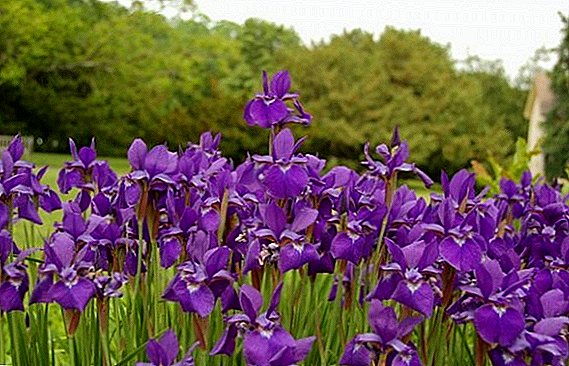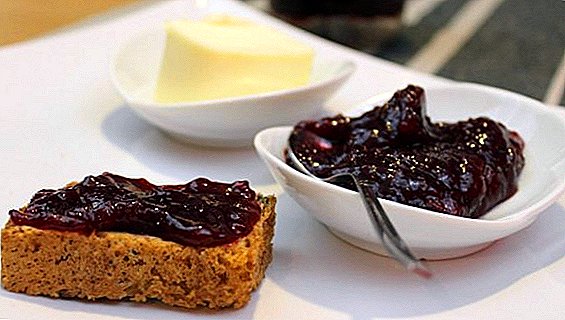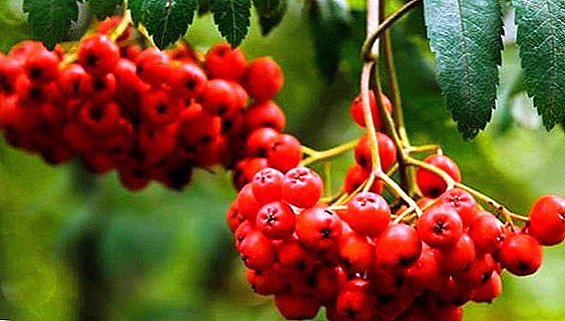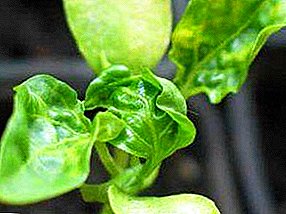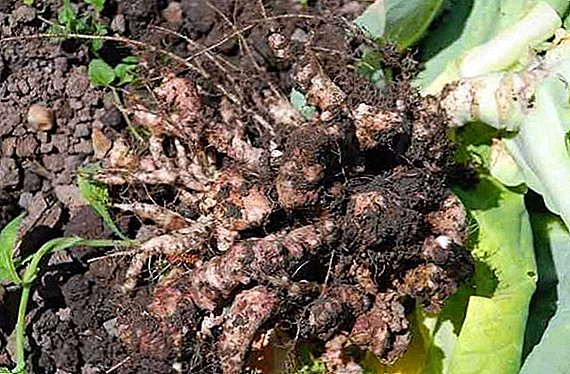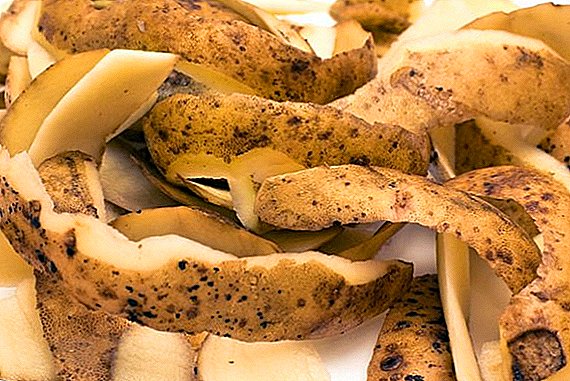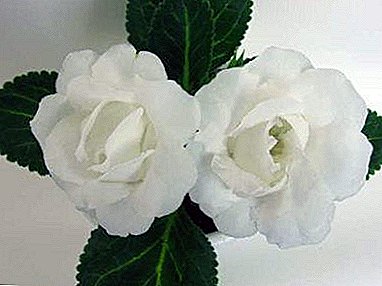
Gloxinia loved by many for its docile nature and attractive appearance. Even a novice in floriculture can grow this plant at home.
Having bought once white gloxinia you will certainly want a large number of these snow-white flowers. Today we will get acquainted with this beautiful gloxinia and find out how to grow it properly.
We consider the methods of its reproduction, the rules of caring for it and possible diseases. We also recommend watching a useful and interesting video on this topic.
General information
White gloxinia - perennial indoor plant. It belongs to the family of Gesneria. It came to us from Brazil, but it is also common in the expanses of America and Mexico. In nature, white gloxinia is a tropical shrub that has fallen in love with rocky rivers and forest thickets.
Flower gained its fame in the eighteenth century.
Popular varieties of white beauty with photos
Gloxinia white terry

It has large white flowers, which have a lemon-colored neck.. It has emerald leaves, short spike, and the plant itself is rather small.
Gloxinia blond Giselle

It has large (up to 10 cm), lush, white flowers that are covered with dark purple "freckles." The middle of the flower is yellowish. Leaves are large, saturated green color.
Appearance
Stems - straight, dense, covered with soft down. The leaves are large, fleshy, pubescent, usually dark in color, but have light streaks. Flowers - single, large, velvety, placed on peduncles. May be pure white or speckled in pink and purple.
- Tropical pink gloxinia.
- Gloxinia varieties of red - Krasnoyarsk and Little Red Riding Hood.
- Flower with beautiful purple hues - Gloxinia Shagane.
Landing rules
It is recommended to grow a plant indoors. For planting, a special primer is used, intended for saintpaulia. A universal mix will do. If you decide to independently prepare a substrate for white gloxinia, then note that the flower prefers turfy soil, with the addition of peat, humus and sand (4: 2: 2: 1). To achieve a lush and long flowering, select a small pot for planting.
Important: Snow-white gloxinia, like all its relatives, loves moisture, but does not tolerate stagnant fluids in the pot. That is why it needs good drainage.
- Drainage is laid on the bottom of the pot (you can use the usual large stones).
- Drainage is poured on top of the substrate.
- Put the tuber or stalk in the pot and sprinkle it with lightly tamping down with primer.
- Water the plant with water at room temperature. This should be done carefully so that moisture does not fall on the stem and leaves of the plant.
Lighting
It is best to choose a well-lit place for a flower. The light should be bright, but diffused, so as not to burn a delicate flower. It is recommended to put gloxinia on the eastern or western windows.
If you provide the plant with proper lighting, then it will please you with abundant and long flowering.
Soil requirements
Soil white gloxinia need soft, loose, airy. Only in such a substrate can a flower actively develop. Be sure to ensure that the soil was nutritious.
Home care
From the right care depends on the general condition of the flower.
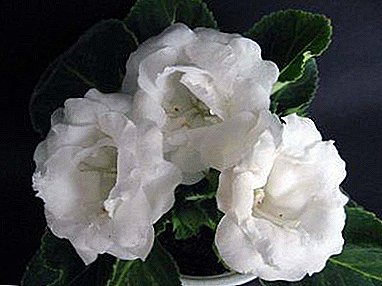 Watering need: in the flowering period - plentiful, in the rest period - moderate. For humidification it is allowed to use only warm separated water. Watering is carried out through the pallet.
Watering need: in the flowering period - plentiful, in the rest period - moderate. For humidification it is allowed to use only warm separated water. Watering is carried out through the pallet.- Daylight hours must be at least 10 hours. If the light is not enough, then you can optionally use artificial lighting.
- Humidity requires increased. It is very important to ensure that moisture does not fall on the plant. This can lead to the decay of the ground part of the flower or even its death. You can spray the air next to the pot or put a vessel with water near it.
- Temperature should be moderate. In the period of active growth and development from 17 to 22 degrees, and in the period of rest - 10-15 degrees. Make sure that there are no drafts!
- Top dressing really need a plant in a period of growth. Make them need about once every 8-10 days. In winter, feeding is stopped. Any special fertilizer for flowering houseplants will do.
- With the arrival of autumn Gloxinia sheds leaves and falls asleep. Rest period Lasts until March.
Watch the white gloxinia care video:
Common diseases and pests
The most dangerous pests of white gloxinia:
- thrips;
- spider mite;
- mealybug;
- schitovka.
To get rid of pests, you must first remove all damaged parts of the plant.. Then it needs to be worked out with its special preparations (fitoverm, aktar, karate).
The most common diseases are:
- powdery mildew;
- late blight;
- gray rot;
- fusarium
If you find any of them need:
- disrupt and destroy all diseased leaves and flowers;
- process the plant with any fungicides (Bordeaux mixture, pre-bicure, copper oxychloride, etc.).
Growing methods: cuttings, seeds or parts of a tuber
White gloxinia, like all its relatives, propagated by cuttings, dividing the tuber and seeds. We analyze in detail each way.
Leaf reproduction
This is the most affordable and easy way. It is enough to cut a healthy, strong leaf with a sharp knife, put it into the water and cover it from above so that it turns out to be a greenhouse. After 10-15 days, young roots will appear, and after another two weeks the plant can be rooted.
Watch the video on the propagation of gloxinia using leaves:
Tuber division
 More risky way. If you make a mistake, you can not only not get a new plant, but also ruin the old one. Tuber for division must be absolutely healthy, elastic, not less than 5 cm in diameter.
More risky way. If you make a mistake, you can not only not get a new plant, but also ruin the old one. Tuber for division must be absolutely healthy, elastic, not less than 5 cm in diameter.
Step by step scheme:
- We disinfect the blade and divide the tuber so that each new part has at least one sprout.
- Slices are treated with activated carbon and dried.
- We plant tubers in the prepared soil, water and wait for their rooting.
Reproduction gloxinia seeds
Perhaps this is the most interesting and effective way. After planting seeds in the ground, you can immediately get a large number of new plants.
Seeds of the white Gloxinia are not expensive (from 40 r), and their germination is high enough. A plant grown from seed will be very strong and durable.
- Prepare a special soil and add a little perlite to it. This will make the soil loose.
- It is best to sow the seeds in a plastic container with a lid. This is due to the fact that for good development of the seeds require greenhouse conditions.
- To evenly distribute the seeds on the surface of the earth, it is recommended to mix them with a small amount of sand and scatter. It is not necessary to sprinkle with earth seeds.
- Watering is done by spraying from a spray bottle.
- We close and open the lid of the container several times a day in order to spray and air it.
- Air temperature for germination should be about 20-22 degrees.
- The main conditions for better development - a lot of light and heat.
The best time for sowing is January or February.. Shoots appear in about 2-3 weeks.
After two leaflets appear on the seedlings, they should be transplanted one by one into disposable cups. The first buds need to nip off in order to strengthen the plant.
Watch a video on breeding Gloxinia seeds:
Similar plants
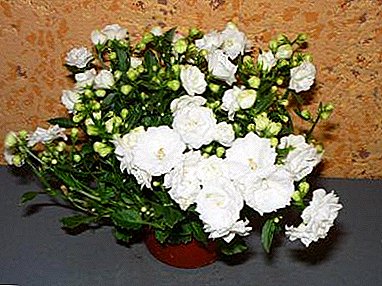 Campanula White Wander (room bell). The plant is similar to gloxinia only in flowers. His bells are the same in form, white, fluffy and large.
Campanula White Wander (room bell). The plant is similar to gloxinia only in flowers. His bells are the same in form, white, fluffy and large.- Streptokarpus "Snow Kilimonzharo" has a similar structure, flowers and leaves. His flowers are also terry, and the leaves are pubescent.
- Ahimenez "Pilou Veit" has very similar flowers in the form of a bell, with a yellow center. But the view of the bush and the leaves are completely dissimilar to the gloxinia.
- Saintpaulia "Rob's Dandy Lion" - a sort of violet, which is very similar to a reduced gloxinia. Flowers, leaves and the very look of the plant is very similar to the snow-white gloxinia.
- Abutilon white very reminiscent of the bells. The plant itself is absolutely unlike gloxinia, but the inflorescences have common features.
- Terry gloxinia Esenia: rules of care.
- How to grow a decorative Gloxinia Sonata at home?
- Rules of planting, care and reproduction of Brokada gloxinia.
- How to home hybrid gloxinia?
- Rosalind Gloxinia - recommendations for the care and reproduction of the flower.
- Features varieties Gloxinia Kaiser Wilhelm and Friedrich.
Conclusion
White gloxinia - amazing flowers! Who has ever grown this wonderful plant will never again refuse it. And with our tips and recommendations care for the flower is not difficult!


 Watering need: in the flowering period - plentiful, in the rest period - moderate. For humidification it is allowed to use only warm separated water. Watering is carried out through the pallet.
Watering need: in the flowering period - plentiful, in the rest period - moderate. For humidification it is allowed to use only warm separated water. Watering is carried out through the pallet. Campanula White Wander (room bell). The plant is similar to gloxinia only in flowers. His bells are the same in form, white, fluffy and large.
Campanula White Wander (room bell). The plant is similar to gloxinia only in flowers. His bells are the same in form, white, fluffy and large.

